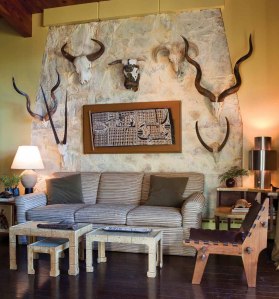
For nearly three decades, interior designer Carey Maloney and his husband and business partner, architect Hermes Mallea, have created stunning spaces for clients around the world through their company M (Group). This month, Maloney is giving readers a detailed look at his design process, inspirations and ideas with a new book called Stuff, published by Pointed Leaf Press. But the tome is more than a portfolio of pretty interiors or striking architecture—it features an interactive component that allows readers to access the museums, dealers, shops and more that Maloney himself consults through the Digimarc Discover app (users just hover their phone over one of 40 topic pages, including Australian aboriginal art and pre-Columbian pottery, to get the information).
Here, Maloney talks to TIME about his earliest collecting memories, his favorite rooms and bringing design to the digital space.
What’s the first thing you remember buying?
A rubber rattle snake that I bought at a Texas state prison rodeo. I was four. I lost it before we got back to the car, which caused a tantrum so that story has sort of become family lore. I looked around my apartment the other day, and the place is scattered with snakes, so it’s obviously something I’ve kept on buying. Then years later, for one Pound in London, I bought a coin that commemorated the sinking of the Lusitania. I still have it, and it’s traveled with me all my life since I bought it at 12.
What inspired you to document your ‘Stuff’ in this book?
I’ve been trying to figure out how to do a book about our work for the past few years now. We had a bunch of pictures we wanted to use, but looking at them, it was more about history and inspirations than the objects themselves. For example, there was a great red library we did for a woman, but the point of the red was its relationship to Egyptian antiquities, particularly the torso of a statue. That’s what interested me—not describing how we got the great red, but what the big picture was. What was also special about doing this book is that my husband and I got to consult the archives of the New York Public Library for research—that was amazing because it’s an institution we’ve been volunteering at for 30 years.
So much of your work—for yourself and your clients—references art history. Were you interested in history first, or collecting?
History first. I was interested in Roman history since elementary school and my partner has a Master’s in historic preservation. When I worked at Christie’s, my heroes were the generalists, not the experts who knew about one field. I admired the guys who could walk into an incredible place and pick out the great things from all genres and periods.
For beginner collectors, how do they walk through a market and determine what’s a gem and what’s just, well, stuff?
When I was 21 and traveling and buying a piece of African art, it wasn’t good, necessarily, but it certainly made me happy. Now I have the high-end, great version of that same piece. But you just start with things that you like and you quickly figure out—and a lot of it is common sense—what has age, what has history. But I don’t find that to be too important in the sense that it’s about an object at the beginner’s level. And when you get really into collecting—and you’re spending a great deal of money on it—then you can be more particular about its value, or what it’ll be worth ten years from now.
You have an apartment in Manhattan and a house in upstate New York. What’s your favorite room in each?
In New York City, the dining room. I don’t have dinner parties, but I love a big table. It opens on to the living room and I can sort of see everything from that one place, and a dining room table isn’t litered with things. I find that refreshing. And upstate, it’d have to be the bar (pictured at top). It’s the kind of piece that I was completely enamored with as soon as I turned the corner when we first looked at the house.
You’ve collected so much from your travels. What’s next on your itinerary?
Southeast Asia is on the top of the list. Laos, Vietnam—there are so many cultures in the region we want to see. And unlike a place like India, which has a great literary history in fiction and nonfiction—meaning travelers sort of know what they can expect—there’s much less of that for Southeast Asia.



